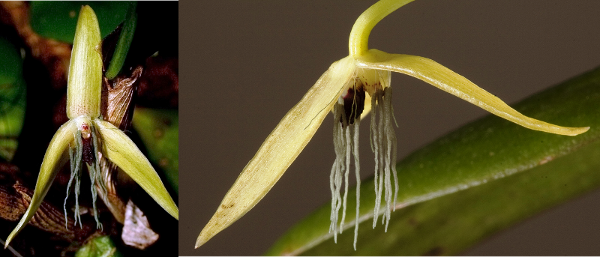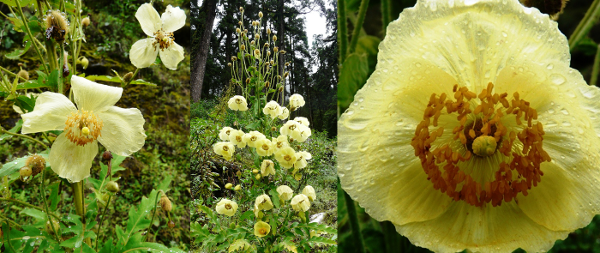Le Top 2012 des nouvelles espèces
L’International Institute for Species Exploration (IISE) édite chaque année le Top 10 des nouvelles espèces découvertes.
Parmi le top 10 des espèces décrites en 2011 se trouvent une orchidée, un coquelicot et un champignon. Présentation de celles-ci, en anglais.
Bulbophyllum nocturnum

Photo credit left: Jaap Vermeulen; right: Andre Schuiteman
Name: Bulbophyllum nocturnum
Common Name: Night-blooming Orchid
Family: Orchidaceae
How it made the Top 10: The discovery of this new species is significant because it has the first night-blooming flowers recorded among the more than 25,000 known species of orchids. Within the orchid family, its genus (Bulbophyllum) is spectacularly diverse with about 2,000 named species. The slender bizarre-looking flowers of Bulbophyllum nocturnum are rather small and start to open around 10pm but close the next morning, lasting only about 12 hours. This new species is known from a single plant and may be at risk due to habitat loss from logging practices in its native New Guinea.
Etymology: nocturnum from the Latin word meaning “at night” to reflect the orchid’s night-time blooming.
Type Material: Holotype – Papua New Guinea Forest Research Institute, Papua New Guinea National Herbarium; isotypes – Royal Botanic Gardens Kew and National Herbarium of the Netherlands.
Type Locality: New Britain, Papua New Guinea
Reference: Schuiteman, A., Vermeulen, J.J., De Vogel, E. & Vogel, A. (2011). Nocturne for an unknown pollinator: first description of a night-flowering orchid (Bulbophyllum nocturnum). Botanical Journal of the Linnean Society 167, 344 – 350.
Meconopsis autumnalis

Photo credit: Paul Egan, Meconopsis autumnalis flowering in the wild at 4000 m, Nepal Himalaya
Name: Meconopsis autumnalis
Common Name: Nepalese Autumn Poppy
Family: Papaveraceae
How it made the Top 10: Many newly discovered species are small in size or secretive in habits, but not all. This beautiful and vibrantly colored poppy has remained unknown to science until now. This is no doubt due in part to the extreme environment where the flower lives at an elevation of 10,827 to 13,780 feet in central Nepal. It is also evidence of the paucity of botanists studying the Asian flora as specimens of Meconopsis autumnalis had been collected twice before, although not recognized as new — first in 1962 by the storied Himalayan plant hunter Adam Stainton and again in 1994 by staff of the University of Tokyo’s Department of Plant Resources. The recent rediscovery of the poppy in the field was made by intrepid botanists collecting plants miles from human habitation in heavy monsoon rains.
Etymology: autumnalis to reflect the autumn season when the plant flowers.
Type Material: Holotype and isotypes – Royal Botanic Garden Edinburgh
Type Locality: Ganesh Himal (Rasuwa District), central Nepal
Reference: Egan, P.A. (2011). Meconopsis autumnalis and M. manasluensis (Papaveraceae), two new species of Himalayan poppy endemic to central Nepal with sympatric congeners. Phytotaxa 20: 47 – 56.
Spongiforma squarepantsii

Photo credit: Thomas Bruns, Interior (left) and exterior (right) views of Spongiforma squarepantsii; center: Dennis E. Desjardin & Andrew Ichimura, SEM photograph of spores of Spongiforma squarepantsii
Name: Spongiforma squarepantsii
Common Name: Spongebob Squarepants Mushroom
Family: Boletaceae

How it made the Top 10: Named after the cartoon character Spongebob Squarepants, this new species looks more like a sponge than a stereotypical mushroom and its fruiting body can actually be squeezed like a sponge and bounce back to its normal size and shape. This unusual mushroom is only the second species of the bolete fungus genus Spongiforma and according to the authors, “its unusual shape is unlike anything else known.” Beyond having a shape that brings Spongebob Squarepants to mind, the authors note other similarities between the fungus and the cartoon personality. The mushrooms smells fruity and Spongebob lives in a pineapple; magnified, the texture of the fungus resembles the tube sponges covering the seafloor where Spongebob lives; and even the microscopic spores of the fungus appear spongelike. Although the species name was initially rejected by journal editors as « frivolous, » the authors persisted and as a result, brought attention to a bizarre new species and to the biodiversity of the world’s forests.
Etymology: squarepantsii is named after the species’ resemblance to the well-known cartoon character Spongebob Squarepants; Spongiforma is genus of sponge-like fungi that was named in 2009 by Desjardin, Manf. Binder, Roekring & Flegel
Type Material: Holotype – University of California at Berkeley.
Type Locality: Lambir Hills National Park, Sarawak, island of Borneo, Malaysia
Reference: Desjardin, D.E., Peay, K.G. & Bruns, T.D. (2011). Spongiforma squarepantsii, a new species of gasteroid bolete from Borneo. Mycologia, 103(5), 1119-1123.
– Voir toutes les espèces du Top 10 2012 de l’IISE
(Tamoya ohboya, the Oh Boy! jelly)
——–
Image d’illustration : Roy Mattappallil, roym on SXC.hu